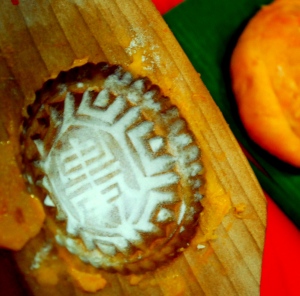
If at first you don't succeed, you have to try and try again. And that's what I did Sunday afternoon. I have been wanting to make the Chinese kueh, angku, since Chinese New year in February but never got around to it. Recently though, I got my hands on a new kitchen gadget -- the Tupperware "Steam It", a steamer made from made-to-witshstand-heat plastic. All you gotta do is place it in a kuali of boiling water (there is a ridge outside the steamer to indicate how high the water level should be) and voila, you're food is steamed. So new steamer + free Sunday = time to get down to making them angkus.
In case you're not familiar, angku is kind of an auspicious chinese dessert or kueh that's commonly made on special occassions, like celebrating the birth of a kid, etc. It's also called "red turtle cakes" (the colour red symbolises prosperity and the turtle, longevity) or "longevity cakes". The angku has a pastry made from glutinous rice flour + sweet potato and is filled with mashed and sweetened mung beans. It's delicious, sticky and sweet.
The processes involved in making the angku isn't difficult. It's a little time consuming but its pretty easy. What's difficult is shaping them in the angku mould. It seems an easy enough task but you need to oil your palm and thereby the dough (it has to be just right) before you pack it into the mould (usually with a carved turtle design) and knock it out. My first attempt was abysmal (top, right). I finally got it right on my third attempt.
There are two parts to making the angku. First you make the filling. You have to soak the shelled split green peas overnight and the steam them (pic below, left) and mash them to a paste (pic, below right). Then you cook them in syrup (low heat) till it thickens.

Next the dough. First, steam (thats the pic of the Steam It below) the sweet potato and mash it up. Mix in half the measure of glutinous rice flour, coconut milk, sugar and a pinch of salt to form a dough.
Put to simmer some coconut milk and as it starts to simmer, add in the other half measure of glutinous rice flour and stir to form a thick dough.

Let cool and combine both the sweet potato dough with the white dough. Add a few drips of orange colouring and transfer onto a floured surface and knead to blend the components together.
Now come the tricky part I was telling you about earlier. Oil your hands and shape little lime size balls with the dough. Make a hollow in the centre of the balls and fill the hollow with the paste. Seal it up well and roll into a ball once again and then press into the mould well (you have to dust the mould with some dough first). Knock the dough out, place on an oiled banana leaf square and steam.
This picture above, by the way, is of my first batch of angkus. Tasted yummy but looked like blobs. Blindfolded, they were perfect. Since it was my very first attempt, I wanted them to be featured, as disfigured as they may be.
One last word on the Steam It -- though small in size (if you're planning on cooking for an army or a gathering, that is), it's really neat. Unlike the bamboo or aluminium steamers, food doesn't stick to the base of the Steam It because of the ridges that run round the diameter of the tray. Am loving it!
Kueh Angku
Pastry
200g or 1.5 cups sweet potato, steamed and mashed
400g (2.5 cups) glutinous rice flour
300 ml (1.25 cups) coconut milk
3 tbsp sugar
pinch of salt
orange colouring
Filling
500g (2.5 cups) shelled mung beans, soaked overnight
500g (2 cups) castor sugar
1. Let's start with the filling first. Steam the mung beans for about 15 mins till soft and mash them. Boil 200 ml (1 cup) water and add the 2 cups sugar and boil till it becomes a thick syrup. Add the mashed beans and cook on low heat till it becomes thick and dry. Set aside to cool.
2. Mash the steamed sweet potato. Add half the glutinous rice flour, half the coconut milk, all the sugar and salt. Mix to form a dough.
3. Simmer the remaining coconut milk and add the remaining flour, stir to form a dough. Mix with sweet potato dough. Add colouring and transfer onto a floured surface and knead to blend both doughs and the colouring.
4. Oil the palm of your hands and divide dough into lime sized balls. Press each ball down to a hollow in the centre and spoon in the filling (not too much else you cant seal it) and seal the dough.
5. Dust mould with flour and press the oiled dough balls into it. Apply gentle pressure so the design of the mould sticks to the dough.
6. Knock the mould lightly on your work surface to remove the dough. Place on oiled banana leaf squares and steam for 15 mins.



not a fan.... much prefer ondeh ondeh! make that please? (or have you already??)
ReplyDeleteYou will find the onde onde recipe in the post titled "I love Malaysian food" :)
ReplyDelete[...] weekend. Whoopee. I had a whole box full of extra mung bean paste from a week ago (the result of my angku kueh) and I decided to try making mung bean pastry [...]
ReplyDelete